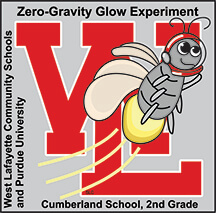Purdue students help send grade school experiment into space
September 14, 2015
 |
WEST LAFAYETTE, Ind. —Aerospace engineering students at Purdue University are teaming with local second-graders to find out if fireflies can light up in space.
The collaborative experiment emerged from a question about fireflies brought up in Maggie Samudio's second-grade class at Cumberland Grade School in West Lafayette. She emailed the question to Steven Collicott, professor of aeronautics and astronautics at Purdue's School of Aeronautics and Astronautics.
"I started to type in an answer saying it should be this or that," he said.
But Collicott, who has taught a zero-gravity flight experiment class since 1997, thought of another idea. He invited Samudio and her second-graders to investigate the question by partnering with his students to create an experiment mixing the relevant chemicals during the weightlessness of a spaceflight and observe the results.
The experiment will access to several minutes of sub-orbital space flight through the Arete-STEM Foundation. The foundation works with commercial sub-orbital rocket companies, offering schools a relatively inexpensive way to reach space.
Collicott and a couple of his students visited Samudio's class recently to talk about putting the experiment together. Imaginative suggestions by the students ranged from training real fireflies to building a robotic firefly to go up in the rocket.
"We talked about whenever we work on this project, let's keep the mission objective in mind," he said. "We talked about how we're not going to train fireflies, so we're working with the chemistry of the firefly glow."
The experiment has several facets, including the size itself. All of the materials and necessary equipment to record the results must be self-contained in a 4-inch cube.
The students were shown some of the hardware involved and left with several open-ended questions to consider about the experiment, including how to mix the chemicals and how to record the results.
The resulting discussions have the gears turning for the elementary students. Collicott said parents have emailed Samudio with stories about the children talking about the experiment at home.
"I think it's really exciting that second-graders are going to have a space flight experiment," Collicott said. "I've been teasing my Purdue students that they're going to be obsolete."
On campus, four students from Collicott's class are working on the nuances of the experiment. Given the time needed to build and test it with the help of Samudio's class, Collicott expects the experiment to be finished in May and go up in a rocket in fall 2016.
The school's experiment is booked on the first research flight by the Arete-STEM Foundation.
"Cumberland School is helping lead the way into a new educational era in which K-12 school spaceflight experimentation can be as common as school orchestras," Samudio said.
The cost of the flight is $3,000, a portion of which has already been raised, Collicott said. The West Lafayette Schools Education Foundation is handling donations.
The flight is expected to go up from a public airport in either California or Texas. Collicott said the students, parents and teacher will be able to attend.
"We're looking forward to traveling to the launch," he said.
Writer: Brian L. Huchel, 765-494-2084, bhuchel@purdue.edu
Source: Steven Collicott, 765-494-2339, collicott@purdue.edu

